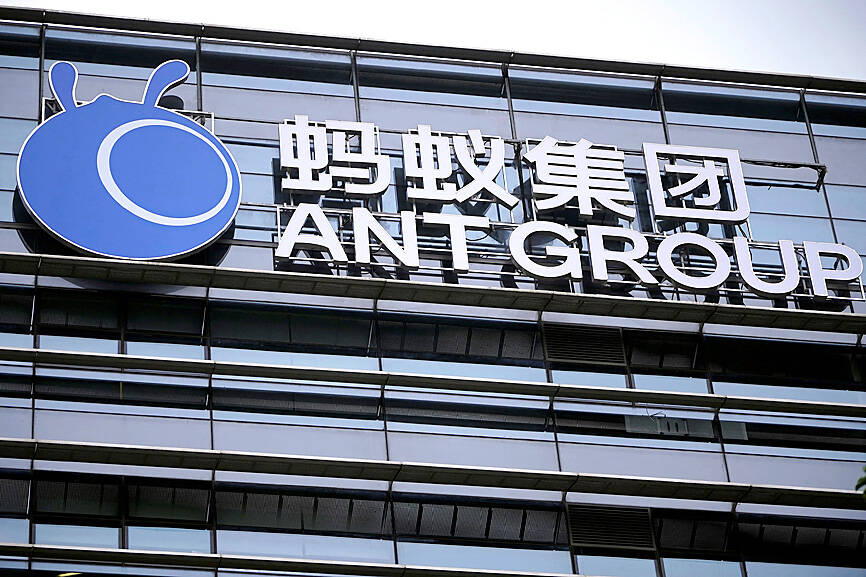Alibaba Group Holding Ltd (阿里巴巴) cofounder Jack Ma (馬雲)-backed Ant Group Co (螞蟻集團) used Chinese-made semiconductors to develop techniques for training artificial intelligence (AI) models that would cut costs by 20 percent, people familiar with the matter said.
Ant used domestic chips, including from Alibaba and Huawei Technologies Co (華為), to train models using the so-called “mixture of experts” machine learning approach, the people said.
It got results similar to those from Nvidia Corp chips, such as the H800, they said.

Photo: AFP
Hangzhou-based Ant is still using Nvidia for AI development, but is now relying mostly on alternatives, including from Advanced Micro Devices Inc and Chinese chips for its latest models, one of the people said.
The models mark Ant’s entry into a race between Chinese and US companies that has accelerated since DeepSeek (深度求索) demonstrated how capable models can be trained for far less than the billions invested by OpenAI and Alphabet Inc’s Google.
It underscores how Chinese companies are trying to use local alternatives to the most advanced Nvidia semiconductors. While not the most advanced, the H800 is a relatively powerful processor and is barred by the US from China.
The company published a research paper this month that said its models at times outperformed Meta Platforms Inc in certain benchmarks, which has not been independently verified.
However, if they work as advertised, Ant’s platforms could mark another step forward for Chinese AI development by slashing the cost of inferencing or supporting AI services.
Ant said it cost about 6.35 million yuan (US$875,952) to train 1 trillion tokens using high-performance hardware, but its optimized approach would cut that down to 5.1 million yuan using lower-specification hardware.
Tokens are the fundamental units of text — such as words, characters or parts of words — that a language model breaks down and analyzes to understand context, meaning and structure.
In essence, they are the building blocks that enable the model to interpret human language and produce intelligent output.
The company plans to leverage the recent breakthrough in the large language models it has developed, Ling-Plus and Ling-Lite, for industrial AI solutions including healthcare and finance, the people said.
On English-language understanding, Ant in its paper said that the Ling-Lite model did better in a key benchmark compared with one of Meta’s Llama models.
Ling-Lite and Ling-Plus models outperformed DeepSeek’s equivalents on Chinese-language benchmarks.
Ant has made the Ling models open-source. Ling-Lite contains 16.8 billion parameters, which are adjustable settings that work like knobs and dials to direct the model’s performance.
Ling-Plus has 290 billion parameters, which is considered relatively large in the realm of language models. For comparison, experts estimate that ChatGPT’s GPT-4.5 has 1.8 trillion parameters, MIT Technology Review said. DeepSeek-R1 has 671 billion.
The company faced challenges in some areas of the training, including stability.
Even small changes in the hardware or the model’s structure led to problems, including jumps in the models’ error rate, it said in the paper.
Additonal reporting by staff writer

TARIFFS: The global ‘panic atmosphere remains strong,’ and foreign investors have continued to sell their holdings since the start of the year, the Ministry of Finance said The government yesterday authorized the activation of its NT$500 billion (US$15.15 billion) National Stabilization Fund (NSF) to prop up the local stock market after two days of sharp falls in reaction to US President Donald Trump’s new import tariffs. The Ministry of Finance said in a statement after the market close that the steering committee of the fund had been given the go-ahead to intervene in the market to bolster Taiwanese shares in a time of crisis. The fund has been authorized to use its assets “to carry out market stabilization tasks as appropriate to maintain the stability of Taiwan’s

STEEP DECLINE: Yesterday’s drop was the third-steepest in its history, the steepest being Monday’s drop in the wake of the tariff announcement on Wednesday last week Taiwanese stocks continued their heavy sell-off yesterday, as concerns over US tariffs and unwinding of leveraged bets weighed on the market. The benchmark TAIEX plunged 1,068.19 points, or 5.79 percent, to 17,391.76, notching the biggest drop among Asian peers as it hit a 15-month low. The decline came even after the government on late Tuesday authorized the NT$500 billion (US$15.2 billion) National Stabilization Fund (國安基金) to step in to buoy the market amid investors’ worries over tariffs imposed by US President Donald Trump. Yesterday’s decline was the third-steepest in its history, trailing only the declines of 2,065.87 points on Monday and

TAKING STOCK: A Taiwanese cookware firm in Vietnam urged customers to assess inventory or place orders early so shipments can reach the US while tariffs are paused Taiwanese businesses in Vietnam are exploring alternatives after the White House imposed a 46 percent import duty on Vietnamese goods, following US President Donald Trump’s announcement of “reciprocal” tariffs on the US’ trading partners. Lo Shih-liang (羅世良), chairman of Brico Industry Co (裕茂工業), a Taiwanese company that manufactures cast iron cookware and stove components in Vietnam, said that more than 40 percent of his business was tied to the US market, describing the constant US policy shifts as an emotional roller coaster. “I work during the day and stay up all night watching the news. I’ve been following US news until 3am

TARIFF CONCERNS: The chipmaker cited global uncertainty from US tariffs and a weakening economic outlook, but said its Singapore expansion remains on track Vanguard International Semiconductor Corp (世界先進), a foundry service provider specializing in producing power management and display driver chips, yesterday withdrew its full-year revenue projection of moderate growth for this year, as escalating US tariff tensions raised uncertainty and concern about a potential economic recession. The Hsinchu-based chipmaker in February said revenues this year would grow mildly from last year based on improving supply chain inventory levels and market demand. At the time, it also anticipated gradual quarter revenue growth. However, the US’ sweeping tariff policy has upended the industry’s supply chains and weakened economic prospects for the world economy, it said. “Now